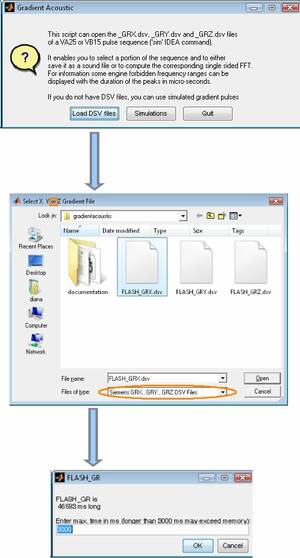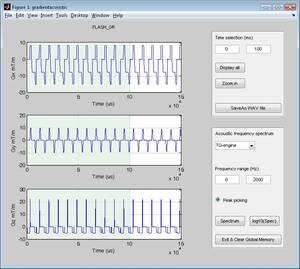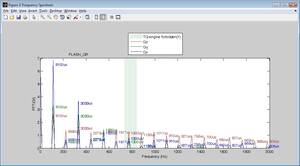Table of Contents
Acoustic frequency tool for the analysis of MR gradient pulse sequences
– Visualization of acoustic frequencies caused by switching of gradients during an echo planar sequence as secondment with ULeipzig ER C. Labadie
During a scan a preselected set of defined radio frequencies and gradient pulses are repeated many times, wherein the time interval between pulses and the amplitude and shape of the gradient waveforms will control the NMR signal reception. Specific pulse sequences weightings are dependent on the field strength.
Lorenz force and sound level pressure
The creation of large magnetic fields within whole body MRI scanners is exacerbated by the need to switch the gradients rapidly, particularly in faster imaging methods (echo planar imaging, EPI). The resulting Lorentz forces and consequent torques applied to the coil structure together with individual wire movements can advance high level of undesirable acoustic noise. [Chapman 1995]
Various approaches have been used to reduce acoustic noise emissions since the loud noises might be amplified and become dangerous for the safety of the patient (possibly hazardous to hearing, physiological consequences, permanent hearing loss) [McJury 2000, Li 2008, Shellock1998, Moelker 2004]. Newer pulse sequences are high intensity, impulse/impact noises that may cause discomfort to patients as well as anxiety in the test environment and a possible loss of hearing for susceptible individuals. [Counter 1997]. Possible hearing damage approx. 120 dB [Wikipedia]
Important echo planar imaging (EPI) safety issue
Gradient systems of an MR scanner have mechanical resonances. If the primary frequency of the excitation pulse sequence falls at or close to a vibration resonance frequency of the gradient coil (dictated by the coil structure and supports), large vibration amplitudes will be induced, which will turn in high acoustic noise levels [Yao G.Z. 2004]
Operating within the range of acoustic resonance frequencies:
- may damage to the gradient system
- may lead to unexpectedly high helium boil-off
- may generate loud gradient noise
- may cause hearing damages (patient/volunteer and persons in examination room should use hearing protection, such as headset, ear plugs)
Write sequences in a way that keeps the gradients away from acoustic resonance frequencies:check echo spacing of rapid echo planar imaging sequences (EPI), simulate sequences with a system that best describes your scanner!
MATLAB script to check whether your pulse sequence peaks fall into acoustic ranges
The Matlab script we created is called gradientacoustic at in can be used to import your Siemens pulse sequence files (*.dsv). After you select your files to import, the script displays the time domain shape of your x, y, and z Gradients. The MATLAB script can be used for following main functions:
- simulation of trapezoidal sequences
- load simulated gradient files (DSV, Siemens IDEA VA25, VB15)
- enables to zoom-in into critical parts of the sequence
- selection of gradient engines (e.g.TQ-engine)
- single sided FFT
- peak picking and peak labeling in micro-second
References
[Tomasi 2003] Dardo G. Tomasi, Thomas Ernst. Echo Planar Imaging at 4 Tesla With Minimum Acoustic Noise. J. Magn. Reson. Imag. 18 (2003) 128-130.
[Counter 1997] S. Allen Counter, Åke Olodsson, H.F. Grahn, Erik Borg. MRI Acoustic Noise: Sound Pressure and Frequency Analysis. J. Magn. Reson. Imag. 7 (1997) 606-611
[Shellock 1994] F G Shellock, S M Morisoli and M Ziarati. Measurement of acoustic noise during MR imaging: evaluation of six “worst-case” pulse sequences. Radiology (1994)
[Cho ZH 1998] Cho ZH, Chung ST, Chung JY. A new silent magnetic resonance imaging using a rotating DC gradient. Mang Reson Med 1998;39:317-21
[Yao G.Z. 2004] G.Z. Yao, chris K. Mechefske, Brian. K. Rutt, Acoustic noise simulation and measurement of a gradient insert in a 4 T MRI
[Li 2008] Mingfeng Li, Teik C. Lim, Jing-Huei Lee. Simulation study on active noise control for a 4-T MRI scanner. Magn. Reson. Imag. 26 (2008) 393-400
[McJury 2000] Mark McJury, Frank G. Shellock. Auditory Noise Associated With MR Procedures: A Review. J. Magn. Reson. Imag. 12 (2000) 37–45
[Shellock 1998] Frank G. Shellock, Mokhtar Ziarati, Dennis Atkinson, Dar-Yeong Chen. Determination of gradient magnetic field-induced acoustic noise associated with the use of echo planar and three-dimensional, fast spin echo techniques. ISMRM (1998)
[Chapman 1995] BLW Chapman, P Mansfield. Quiet gradient coils: active acoustically and magnetically screened distributed transverse gradient designs Meas. Sa. Technol. 6 (1995) 349-354
[Forbes 2007] Lawrence K. Forbes et al. An Analytical Approach to the Design of Quiet Cylindrical Asymmetric Gradient Coils in MRI. Concepts in Magnetic Resonance Part B. 31B (2007) 218–236


